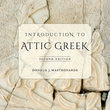|
In the old Attic alphabet Η or heta represented the h-sound. In the Ionic alphabet, the same symbol represented a vowel, eta, because the Ionic dialect had lost aspirations and had no need for heta. When the Ionic alphabet was adopted in Athens (2nd half of the 5th cent. B.C.E.), the h-sound was no longer represented in writing. Subsequently, the rough breathing sign was created by using of the left half of Η to indicate [h], and the smooth breathing sign was created as its mirror image to represent the lack of the h-sound. These signs were introduced by Alexandrian scholars in the 2nd cent. B.C.E. and during the Byzantine period developed into the curved form we now use.
|
 Pronunciation Guide
Pronunciation Guide
